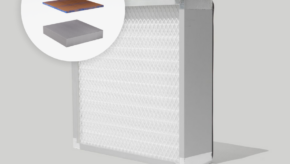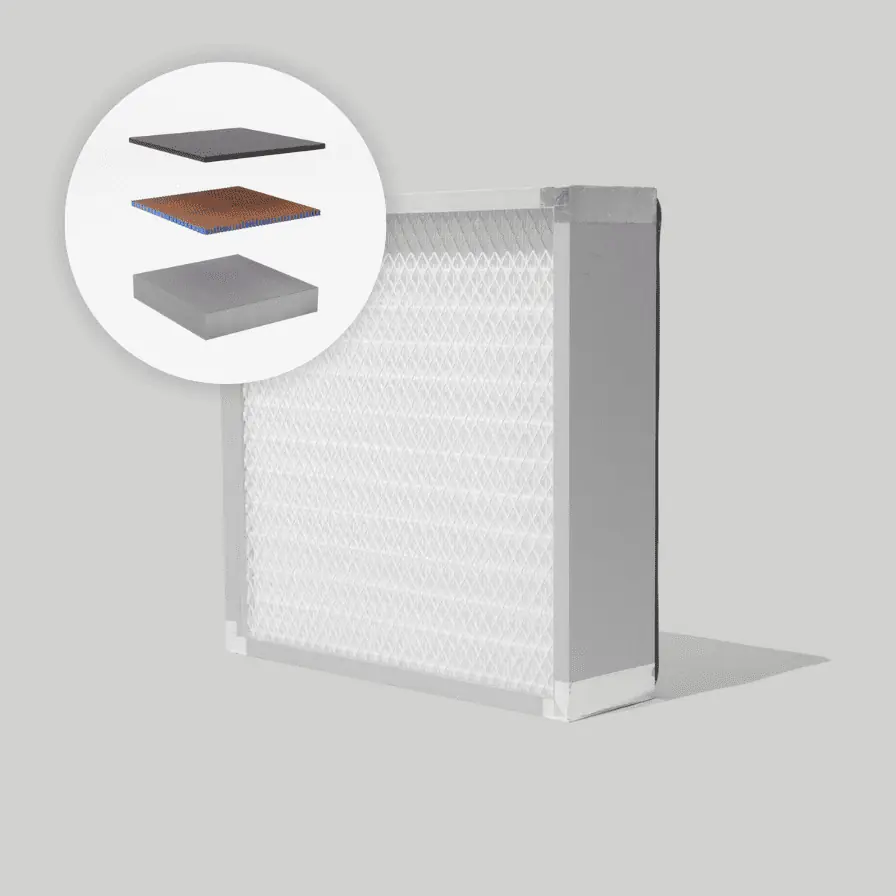This may be the longest flu and cold season you have ever experienced, as your symptoms have progressed for weeks on end – coming and going frequently. The dreaded and hard to distinguish between, colds and flus, are both airborne illnesses that can be significant and come with a bout of symptoms that will leave you calling off work to get some much-needed sleep. During that time of year, nobody is safe from these illnesses, with the most susceptible people to catching these illnesses is school aged children and people who are going to an office every day surrounded by an excess of people who are all in the same work environment.
Bacteria and viruses that lead to these nasty airborne illnesses can settle on a variety of sources including surfaces in the environment, as well as float around in the air that can be easily inhaled by those present in the indoor air space. Traveling by air is one of the most hazardous sources of bacteria and germs, and thus it can significantly contribute to the development of illness in those exposed to these airborne bacteria and viruses.
In this article we are going to discuss the relationship between indoor air quality and airborne illnesses and how you can mitigate these airborne illnesses to protect your health from these bacteria and viruses in the air.
Why Do I Keep Getting Sick?
Have you noticed a continual pattern when it comes to you and your health? The constant battle of fighting off colds and other illnesses, particularly during the flu/cold season of the year. The reality is that some people are more susceptible to sicknesses because of different factors such as a low immune system, other health conditions, and even just the simple fact of exposure to these illnesses in the air. Airborne illnesses spread in the air and when an infected person coughs, sneezes, or talks the bacteria and viruses are emitted into the air and float around looking for its next target, and that could be you!
Bacteria and viruses are ultra-small microscopic organisms that will vary in size depending on the species. Bacteria can be as small as 0.2 micrometers in size, but typically the size of bacteria will range from 1 to 10 micrometers in size. Whereas viruses are generally smaller than that of bacteria, with the smallest virus ranging in size from 0.001 micrometers in size. These germs, however, will not float in the air for very long, as they will eventually land on the surfaces of the environment.
Is a Cold a Virus or Bacteria
When it comes to deciphering between a virus or bacteria illness, it can be difficult to make the identification between the two as they have very similar effects on the human body. Both bacteria and viruses are caused by microbes that will spread throughout the environment into the air. Bacteria, also referred to as bacterium, is a single complex cell that can survive on its own either inside or outside the body. Viruses are smaller non-cells that need a host such as a human or animal to multiply. Viruses are infectious and enter into the host and multiplies rapidly.
Viral infections have been identified as illnesses like the common cold, the flu, coughs, bronchitis, and chickenpox. In comparison, a bacterial infection includes illnesses such as whooping cough, strep throat, ear infections, and urinary tract infections (UTI).
Ultimately, it can be difficult to know what causes both a viral and bacterial infection and it will also be hard to determine the differences between these two illnesses – as their symptoms are closely alike.
Airborne Diseases Symptoms
Many diseases spread through the air and will be classified as an airborne disease. The different illnesses that can be classified as airborne diseases can include the common cold, influenza (the flu), chickenpox, mumps, measles, whooping cough, and tuberculosis. Each of these airborne diseases can present varying symptoms to the health of those impacted by these illnesses.
Airborne diseases usually though, result in one or more of the following symptoms:
- Coughing
- Sneezing
- Congestion
- Runny nose
- Sore throat
- Inflammation of the sinuses
- Headaches
- Body aches
- Loss of appetite
- Fatigue
- Fever
The Relationship Between Indoor Air Quality & Airborne Sickness
The bacteria and germs that become airborne make their way into the air by floating in from outside and being carried indoors through clothes and other materials on individuals. The small contaminants will float within the air and have the strong potential to be inhaled or ingested in the body, triggering the commencement of a viral or bacterial infection.
Many environments where there is poor circulation and an excess of people, such as public transportation, office environments, and schools, can make it easy for airborne organisms to spread. These organisms spread, as they thrive and circulate throughout the damp, humid air. Therefore, humidity is a major contributor to the promotion of viruses and bacteria in the air space.
Generally, improving the indoor air quality in your home will not get rid of illnesses, but it will help to soothe and ease some of the persisting symptoms of these illnesses. For instance, if you have a stuffy nose or bad cough, particles and toxins in the air like pet dander, dust, and other allergens can further irritate your respiratory system. By implementing a method to break down these airborne germs and bacteria you will help to reduce the potential symptoms from exposure.
How to Stop Getting Sick
According to the U.S. Centers for Disease Control and Prevention (CDC), there are more than 1 billion cases of the common cold that occur every year in the United States. Many people will accumulate a cold more than once every year, with some people experiencing anywhere from two to four colds in a single year. There are a variety of reasons that can cause the development of these conditions in individuals – including exposure risks, the time of year, weather conditions, and the quality of the air in your environment.
There are no supplemental medications that can aid in the prevention of a cold but there are a few simple steps that can be taken to reduce the potential risks of developing a cold or any airborne illness and this includes the following methods:
- Avoid spreading germs: You never know when you will come into contact with different types of germs and bacteria that are found within the air. In an effort to minimize exposures to these illnesses it is best to avoid touching your eyes, mouth, and nose with your hands – particularly if you come into contact with someone who is sick.
- Wash Hands Frequently: Keeping your hands clean and free of bacteria and germs will be necessary to combat any illnesses in the environment. When you wash your hands with soap and water it will fight off the risks of getting a cold by destroying the virus you have picked up from somewhere or someone.
- Limit Exposure to Sick Individuals: When you are aware that someone is sick that is near your environment be sure to keep a safe distance from the people to avoid catching any of their germs or bacteria. If you are sick, you can help to prevent others from getting sick by avoiding contact with other people and giving them large distances from you and the germs.
- Clean Air is Key: The quality of our air is not something that we often take into consideration when we think about airborne illnesses. During the dreaded cold and flu virus season – there will be large quantities of contaminants and germs/bacteria in the air that can have a significant impact on the health of those exposed. The best way to prevent the exposure to these airborne germs and bacteria is by using an effective air purifier for virus and bacteria removal.
Air Purifier for Viruses & Bacteria Removal
Air purifiers are air cleaning devices that are designed to purify and maintain clean air quality within an indoor environment. There are a wide variety of different air purifiers and air purification technologies that are used in these devices to clean the air. Each technology that is used in air purifiers can have both strengths and weaknesses, and when it comes to the removal of germs and bacteria in the air some just can’t compete.
Ionizers
An ionizer, or ionic air purifier uses a technology that takes electrically charged ions into the air to attract to particles, allowing the ions to attach to the particles causing them to clump together and settle out of the air. When it comes to viruses and bacteria the ionizer may be able to remove them from the air, but these contaminants will just end up settling on the surfaces of the environment. Therefore, leaving the airborne illnesses in the environment for potential exposure and development of the illness in the body.
PECO
There are air purifiers that use the PECO technology, a brand-new patented technology that has many claims at removing pollutants from the air including bacteria and germs. However, the Photo Electrochemical Oxidation (PECO) technology uses a combination of UV-A lights and their technology to entice a reaction between the pollutants and the light. These UV-A lights though can be potentially dangerous to human health. UV-A lights are the type of lights that have the ability to penetrate the second layer of the skin which can be dangerous to human health.
Ozone Generator
A very dangerous air purifier technology, ozone generators cause a chemical reaction with gaseous pollutants. Ozone generators do not work on particles at all, so they are nearly useless when it comes to germs. Even worse, these machines are very harmful to human health as they produce dangerous ozone emissions into the air that can impact the lungs upon exposure.
Ultraviolet Light (UV-C)
An air purifier uses UV-C light as their technology can help to expose microbes in the air to the ultraviolet light, this will kill or inactivate germs and bacteria that come into contact with the light source. The UV-C light when used in conjunction with other technologies such as a HEPA filter will help to capture the microorganism (bacteria, germs, and mold spores) and allow for long exposure times to the germicidal UV-C light. The EnviroKlenz UV Air Purifier uses both a UV-C lights and a HEPA filter to provide this type of removal of airborne bacteria and germs in the air of your indoor environment.
HEPA Filters
A HEPA Filter is a certified filter that is able to trap 99.97 percent of particles 0.3 micrometers in size, so this filter can reduce the number of small particles that carry bacteria and viruses in the air. However, not all viruses and bacteria will be removed in the HEPA filter as some of the particles are smaller than what can be captured by the filter. Also, there is a potential for these germs and bacteria to grow and cultivate on the filter if there is not a control mechanism such as UV-C.
Combating and fighting off allergens is possible particularly with different preventative measures that can be taken. Considering the different factors that can contribute to the development of germs and bacteria such as the indoor air quality, will help you have a better chance at fighting off these airborne illnesses in your personal indoor air.








